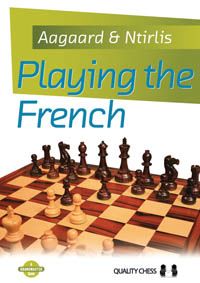Playing the French
Jacob Aagaard, Nikolaos Ntirlis

PLAYING THE FRENCH by Jacob Aagaard and Nikolaos Ntirlis is one stop shopping for those who would like to play the French Defense as Black. The two authors cover all of White tries including the Euwe System (3.e5 c5 4.c3 Nc6 5.Nf3 Bd7) against the Advance Variation, 3…c5 and 4…Qxd5 against the Tarrasch and both the Classical (4…Be7) and the McCutcheon (4…Bb4) against after 3.Nc3 Nf6. The Steinitz Variation (4.e5) is also examined, as is the Kings Indian Attack.
The chapters break down as follows:
1 The Advance Variation 13
2 The Euwe System 27
3 6.a3 53
4 6.Be2 75
5 The Exchange Variation 95
6 The Symmetrical Variation 109
7 Breaking the Symmetry 124
8 The Tarrasch Variation 139
9 4.exd5 Qxd5 Intro and 5.dxc5 159
10 Alternatives to the Main Line 174
11 Main Line with 10.Nxd4 196
12 The Steinitz Variation 218
13 5.Nce2 227
14 Introduction to 7…a6 243
15 The Old Main Line 9.dxc5 265
16 The Modern 9.a3 282
17 The Classical Variation 299
18 Alekhine Gambit with 6…c5! 312
19 Classical 6.Bxe7 Qxe7 328
20 Classical Main Line with 8.Nf3 340
21 The McCutcheon Variation 354
22 6.Bc1 and 6.Be3 373
23 6.Bd2 395
24 The Kings Indian Attack 416
25 Six Rare Birds 437
Critical variations are not shied away from and improvements are given and lines repaired when needed. This includes the important Tarrasch line 1.e4 e6 2.d4 d5 3.Nd2 c5 4.exd5 Qxd5 5.Ngf3 cxd4 6.Bc4 Qd6 7.0-0 Nf6 8.Nb3 Nc6 9.Nbxd4 Nxd4 10.Nxd4 a6 11.Re1 Qc7 12.Qe2! (the new try 12.Bf1 used twice by GM Solak in the 2013 World Team doesnt pose Black any problems) and now the little-known 12…h6!! as 12…Bd6 and 12…Bc5 have been found wanting. This move gets 3 1/2 pages of analysis.
Conventional theory holds that after 1.e4 e6 2.d3 d5 3.Nd2 c5 4.g3 Nf6 5.Bg2 Be7 6.Ngf3 0-0 7.0-0 Nc6 8. Re1 (8.e5 leads to the same position) Black should play 8…b5 and not 8…Qc7, the rationale being that after e5 and a later Bf4 and Ne3 the queen is vulnerable to Nxd5 or Bxd5 followed by e6. Aagaard and Ntirlis get around this problem by ditching the old main line of …a5-a4-a3 and inserting …Rfc8 before retreating with …Qd8 to avoid sacrifices on d5. Black sometimes looks to …Nd4 for counterplay.
One extra bonus is 14 pages of coverage on the Exchange variation which, while not theoretically challenging, does prevent practical problems for higher rated players who play the French.
Highly Recommended
